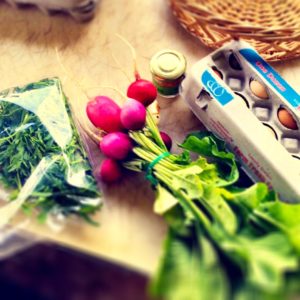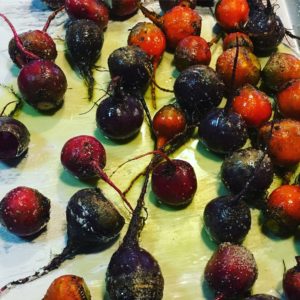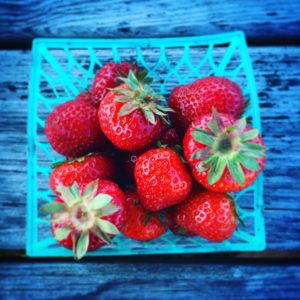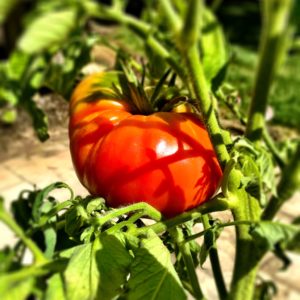Sunshine through my window gives me hope that warmer weather is finally fighting its way back to me. But the nicer weather means more to me than just putting heavy coats away in the closet and the ability to enjoy the outdoors. It means that new seasonal ingredients will allow me to create new recipes to offer my clients.
The cycle of food that is readily available here in the Cincinnati area is ever-evolving and dependent on our weather. Even though you can go to a grocery store like Kroger or a specialty food store like Jungle Jim’s and get just about any produce you want, those items usually traveled pretty far to get to you, and that compromises their freshness and integrity. By utilizing farmer’s markets and local farms and developing my recipes around what’s currently in season at them, I am able to deliver the freshest ingredients to my clients.
Knowing what is in season locally is important to me as a chef, but it can also help you, too! Having the knowledge of what’s in season before you go shopping for your produce can help you be more creative in the meals that you plan.
So what is in season right now, Chef Ken?
Great question. Unfortunately, it’s one that can’t easily be answered because it varies even throughout the area according to growing conditions. The best way to know is to formulate a personal relationship with your local farmers. Ask them: What is in season? What do you have seeded? When do expect to harvest those items? Eventually, you will see a pattern and will be able to anticipate what is in season.
So what is typically in season by month? Here is a list I have come up with for you to reference:
January: broccoli, Brussels sprouts, cabbage, cauliflower, grapefruit, kale, leeks, lemons, oranges, parsnips, rutabagas, tangelos, tangerines, turnips.
February: broccoli, Brussels sprouts, cabbage, cauliflower, grapefruit, kale, leeks, lemons, oranges, parsnips, rutabagas, tangelos, turnips.
March: artichokes, broccoli, Brussels sprouts, cauliflower, leeks, lettuce, mushrooms, parsnips, pineapples, radishes, rutabagas, turnips.
April: artichokes, asparagus, broccoli, cauliflower, leeks, lettuce, mushrooms, pineapples, radishes, rhubarb, spring peas.
May: apricots, artichokes, asparagus, cherries, lettuce, mangoes, okra, pineapples, radishes, rhubarb, spring peas, strawberries, Swiss chard, zucchini.
June: apricots, blueberries, cantaloupe, cherries, corn, kiwi, lettuce, mangoes, peaches, strawberries, Swiss chard, watermelon, zucchini.
July: apricots, blackberries, blueberries, cantaloupe, corn, cucumbers, green beans, kiwi, kohlrabi, lettuce, mangoes, okra, peaches, peppers, plums, raspberries, strawberries, summer squash, Swiss chard, tomatoes, watermelon, zucchini.
August: acorn squash, apples, apricots, blueberries, butternut squash, cantaloupe, corn, cucumbers, eggplant, figs, green beans, kiwi, kohlrabi, lettuce, mangoes, okra, peaches, peppers, plums, raspberries, strawberries, summer squash, Swiss chard, tomatoes, watermelon, zucchini.
September: acorn squash, apples, beets, butternut squash, cantaloupe, cauliflower, eggplant, figs, grapes, green beans, lettuce, mangoes, mushrooms, okra, peppers, persimmons, pomegranates, pumpkins, spinach, sweet potatoes, Swiss chard, tomatoes.
October: acorn squash, apples, beets, broccoli, Brussels sprouts, butternut squash, cabbage, cauliflower, cranberries, grapes, leeks, lettuce, mushrooms, parsnips, persimmons, pomegranates, pumpkins, rutabagas, spinach, sweet potatoes, Swiss chard, turnips, winter squash.
November: beets, broccoli, Brussels sprouts, cabbage, cauliflower, cranberries, leeks, mushrooms, oranges, parsnips, pears, persimmons, pomegranates, pumpkins, rutabagas, spinach, sweet potatoes, tangerines, turnips, winter squash.
December: broccoli, Brussels sprouts, cabbage, cauliflower, grapefruit, kale, leeks, mushrooms, oranges, papayas, parsnips, pears, pomegranates, rutabagas, sweet potatoes, tangelos, turnips.
Now understand that not all of these items will be available in your area strictly according the above calendar. That is why building a relationship with your local farmers is so important. Knowing what to look for when you are at the farmer’s market will help you when looking for the freshest produce to make the most flavorful dishes for you and your family.




Leave a Reply